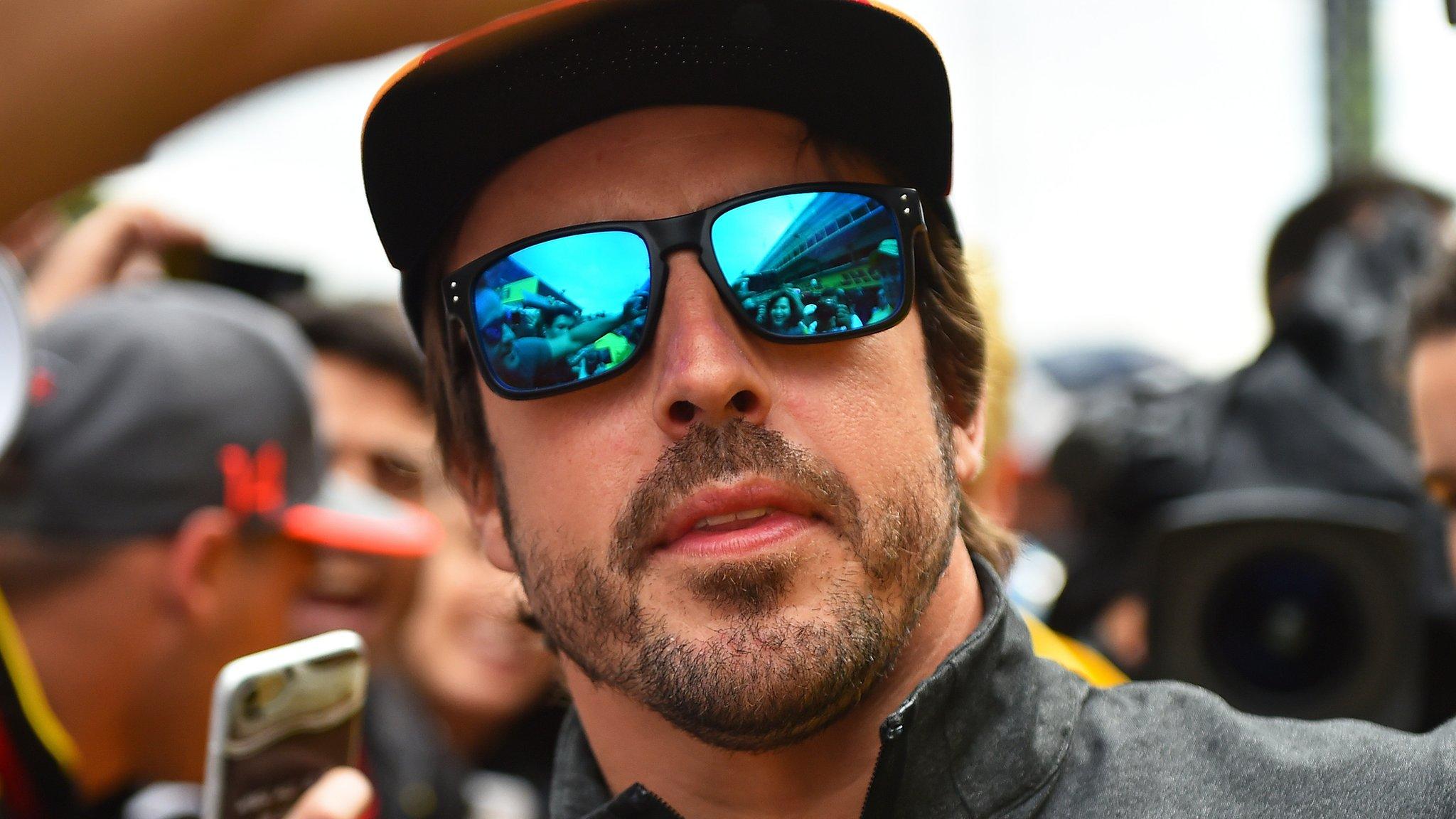Fernando Alonso's Indy 500 odyssey begins here - what can he expect?
- Published
- comments
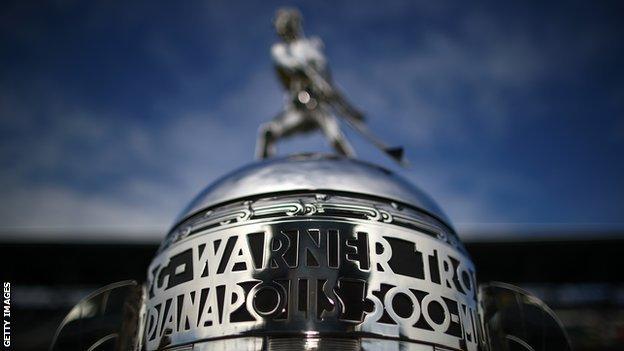
The winner of the Indianapolis 500 is awarded the Borg-Warner trophy
Fernando Alonso says he is "very excited" about his Indy 500 odyssey - and he is not alone.
The two-time F1 champion flew straight from Sunday's Spanish Grand Prix to America to start his attempt to win the Indianapolis 500 on 28 May.
Some measure of the impact his decision has had comes from the fact that more than two million people watched Alonso's first test at the Indianapolis Motor Speedway earlier this month.
Yes, two million people. Watching a webcast of a single car going around a circuit with four left-hand turns.
For Alonso, who is missing the Monaco Grand Prix to race at Indy, this is the next step to trying to win the 'triple crown' of motor racing's three blue-riband events.
'Everything went fine' - Alonso happy with Indy 500 practice
Only one man, Graham Hill, has so far triumphed in Monaco - where Alonso has already won twice - at Indy and in the Le Mans 24 Hours.
And it is a rare chance to taste success at a time when his F1 career is becalmed by poor machinery.
At Indy, Alonso will have a car with which he can win, branded for his McLaren F1 team, run by the elite Andretti Autosport outfit and powered by a Honda engine - which, unlike the one in Alonso's F1 car, is absolutely competitive.
Few would question Lewis Hamilton's assessment that Alonso will be "the best driver in the paddock" at Indy. Less certain is whether he can adapt quickly enough to racing on a high-speed oval.
"He just won't have the time," Hamilton says. "It will be interesting to see how he fares against the drivers who have all this experience."
This is not just any racing driver. Alonso is an exceptional talent.
But he has never raced on an oval before, and is facing highly skilled rivals who have been doing it for years.
So what is Alonso up against, and what makes winning at Indy so difficult?
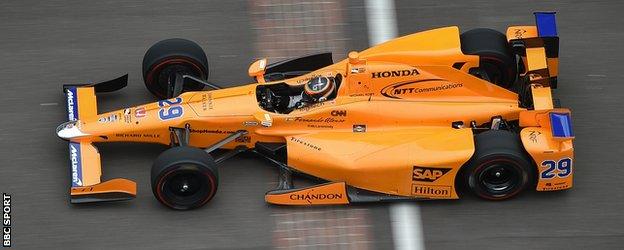
McLaren's historic papaya orange colour scheme will grace this year's Indy 500
The basics
The Indy 500 is 200 laps of a 2.5-mile 'superspeedway' with four left-hand turns banked at an angle of nine degrees, all of which look identical but have their own subtleties.
There are no run-off areas - the track edge is a wall. Average lap speeds top 230mph in qualifying.
It is, needless to say, extremely dangerous, even if safety has been improved in recent years by replacing concrete walls with impact-absorbing barriers in the corners.
All teams use a spec Dallara chassis but there are two engine manufacturers - Honda and Chevrolet - and each can develop its own aerodynamics.
Although the cars are more rudimentary than F1 machinery, there is a level of complexity of set-up on an oval that Alonso has not experienced before.
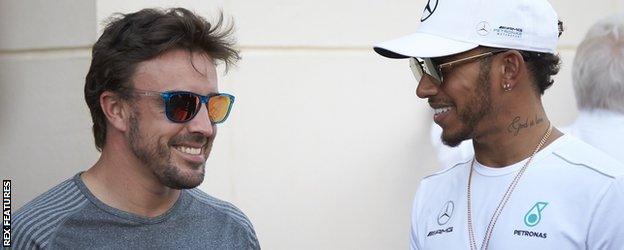
Lewis Hamilton will be watching the progress of his old McLaren team-mate with interest
'Between runs, he sat in the car, his face calm, no wide eyes'
Can Alonso adapt to the challenges of Indianapolis?
The beginnings of an answer were provided by his first run at Indy in early May, which also comprised the mandatory 'rookie test' all drivers new to Indy have to complete.
He was alone on track but it provided compelling viewing. Not only for the fly-on-the-wall nature of the coverage - cameras eavesdropped on Alonso's conversations with his engineers in a way never allowed in F1 - but also for the way he dealt with the day.
The rookie test required a driver to run a series of laps at pre-determined speeds - 10 laps in the range of 205-210mph, 15 at 210-215mph, 15 at 215-220mph. That's a total of 40 laps for the test. Alonso completed it in just 50, including those on which he exited or returned to the pits.
This is not hugely remarkable for a driver of his ability. But there were some eye-opening aspects to the day.
At one point, Alonso was told over the radio that he had completed the 210-215mph phase and could go straight onto the next one. His very next lap was 219.495mph.
The 215-220mph phase completed, he was straight into the high 221mph range, topping out at 222.548mph. "That's a race pace right there," said a watching Mario Andretti, 1978 F1 world champion and 1969 Indy 500 winner.
There was hardly any sense of Alonso playing himself in. He exuded control, as if he did it every day.
If he was feeling intimidated by the speeds involved, there was not a hint of it. Between runs, he sat in the car, his face calm, no wide eyes, no apparent trepidation at all.
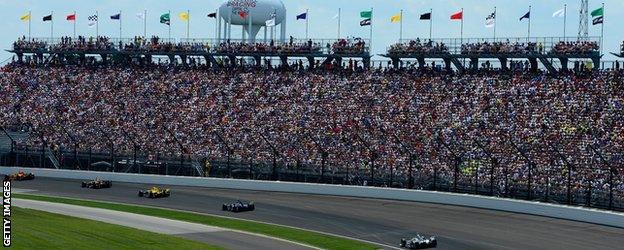
Alonso will face four left-hand turns at the Indy 500 - a far cry from the 19 corners at Monaco
'The guy has incredible feel'
Even to an experienced observer, this was extraordinary.
Scot Dario Franchitti, a three-time Indy 500 winner, said he was "amazed".
"I thought he got up to speed incredibly quickly," he added.
Alonso had arranged for timing data from a 210mph lap to be put on the steering wheel display screen, and calculated what would be the lap-time difference for the increased speeds.
But when I asked 2003 Indy 500 winner Gil de Ferran how Alonso judged it so finely, he made it clear it was a long way from normal.
"The guy has enormous feel. Huge," said De Ferran, who is acting as Alonso's mentor at Indy.
"What makes a great racing driver great? It's feel, man.
"Obviously Fernando is extremely gifted, and I have now also learned that he is highly intelligent, has a great attitude and a great work ethic."
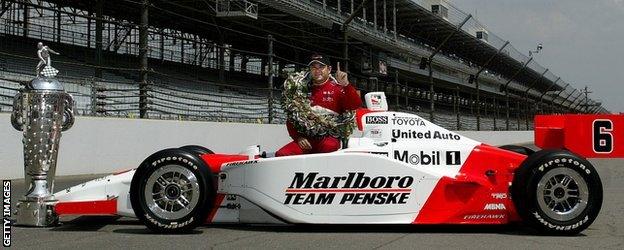
De Ferran is a two-time IndyCar champion
Alonso described his first test as "fun", and did admit to one moment when the speed and the walls got to him.
"The team at one point said: 'You are done with the limitations, so run free as you feel,'" Alonso said.
"I knew Marco [Andretti, who set the car up for Alonso] was flat in Turn One and I said [to myself] I will do it flat out.
"I was convinced 100% I was going flat out but the foot was not going flat out; it had its own life. The second or third lap I was able to do it, but the first lap was a good moment to feel the place, the car.
"The speed is something. For any racing driver, it is just pure adrenaline. It was a good day."
Intimidated, Alonso clearly is not. But he is aware that winning at Indy involves more than just being fast and brave - and that running in traffic in excess of 230mph and working out how to optimise the car are things he has to learn fast.
What does he have to learn?
Alonso has already impressed the Andretti team with his application and his understanding of the differences between what Americans call road racing and oval racing. But the task ahead of him is huge nonetheless.
There are so many differences between F1 and the Indy 500 that it is hard to know where to start.
The speed is one thing - there is not a corner on an F1 circuit anywhere in the world that is taken as fast as the average lap speed Alonso will be doing in the race at Indy, let alone qualifying.
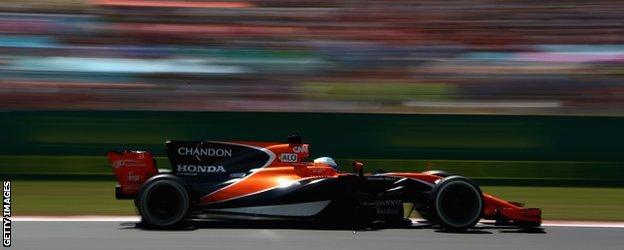
Alonso will reach much greater speeds than he is used to in F1
Whereas an F1 team is not allowed to change the car between qualifying and race, Indy requires two different set-ups for each.
And then there is the complexity of how the cars work on an oval track.
A driver has to turn right to go in a straight line because the cars are designed only to turn left and set up asymmetrically. The idiosyncrasies of oval racing mean that adjustments for handling balance are made not only to the front and rear but also diagonally across the car.
Drivers can change this while out on track with something called a 'weight-jacker' - a kind of diagonal pitch control, which De Ferran says "changes the balance of the car tremendously".
"In a way, you have twice as many variables," De Ferran adds, "and [you have to work out] how does that interact with your driving.
"There are a lot of peculiarities for someone who has never done ovals."
'Like driving on ice at 230mph'
Alonso has five days of practice this week, with six hours of running on each as long as the weather stays fine - IndyCars do not run in the rain on ovals - before qualifying over two days on the weekend of 20-21 May.
In that time, he will have to learn the car, come up with set-ups for qualifying and race, learn how to adjust the car on track for changing conditions and come to terms with running in traffic at more than 220mph.
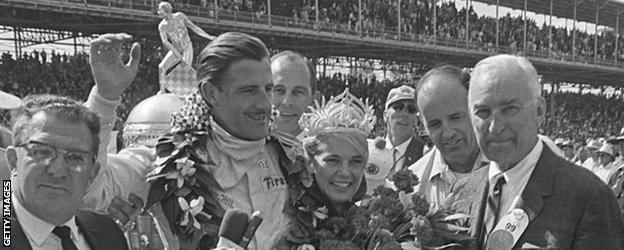
Only Graham Hill has ever won the Monaco Grand Prix, Indy 500 and Le Mans 24 hours
"Qualifying and the race are very different," De Ferran says. "Qualifying at Indy quite frankly is one of the most difficult things I have ever done in a racing car."
A lap of Indianapolis is supposed to be "flat" - the driver never lifts his foot off the accelerator. But it is a long way from easy. The driver is absolutely on the edge, the car in a controlled slide or 'drift', all the time.
The car is 'trimmed out' to have as little downforce as the driver feels he get can get away with - because downforce equals drag and drag slows you down on the straights - while going as fast as possible in the corners.
The result, De Ferran says, is "the car feels like you are driving on an ice road at 230mph. It is very, very little grip and very, very little margin".
The grid is set over two days. Saturday's running fundamentally defines the nine drivers who can compete for pole on the Sunday - the so-called 'Fast Nine'. The remaining 24 also compete for grid slots on the Sunday, but the best they can be is 10th, no matter what time they set. Positions are defined by speed over a four-lap run and the drivers take it in turns to go out.
"One of the unfortunate things sometimes about TV is you can't see how on-the-edge the whole thing is," De Ferran says.
"It may look from TV that the guy is just going round and round and it looks easy, but you ask any driver where they have to do a lot of runs in qualifying trim, they are like, 'Oh my God, this is so stressful. I don't want to do that many runs in qualifying trim. I'm done. Once is enough.' And now they have to do it at least twice and that's difficult.
"You are literally looking for a few centimetres here and there to make a difference. If the tyres go off, if they are degrading a little bit too much because you are sliding a little bit too much, come the fourth lap you are in trouble.
"It is an adventure like you have no idea."
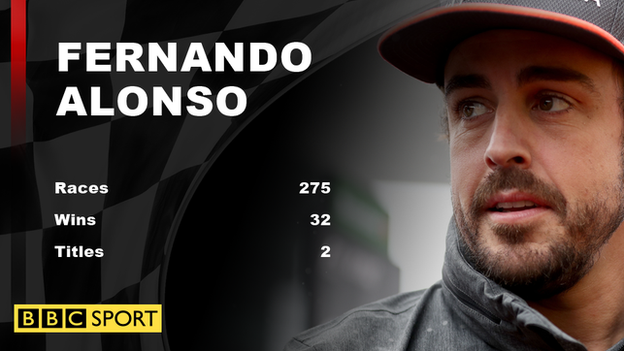
The race - 'a very complex equation'
For the 500 itself, there is a "completely different set of problems," De Ferran explains.
The driver still wants to be running as little downforce as possible because, as De Ferran puts it, "the less downforce you can run, the quicker you will go".
But he has to run more than in qualifying because of the problems created by racing in the vicinity of 32 other cars. Traffic messes up the behaviour of the car.
"That's one of the big difficulties - how much downforce do you add?" De Ferran says. "Because the more you add, the more you slow down. Alone. In perfect conditions.
"Now you have to do 30 laps [in a stint] instead of four. And you have to take tyre degradation and traffic into account.
"It may be traffic from a line of cars, from one car, and when you are in traffic you lose downforce and the car starts sliding like mad and then you can't go forward.
"The mindset from a set-up perspective for the race is quite different than in qualifying."
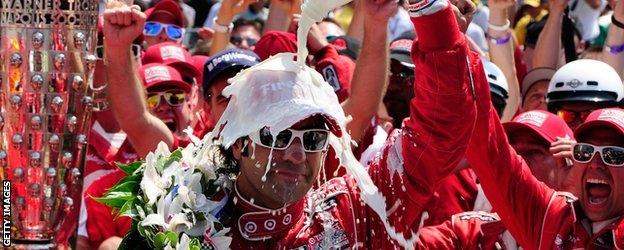
If Alonso wins, he'll have to trade in the champagne he's used to for a bottle of milk - 2012 winner Dario Franchitti here showing him how it's done
A driver may want his car to behave differently in the race so it is less on-a-knife-edge than he can get away with for four laps of qualifying.
"Balance-wise you may not want the car to be quite as neutral," says De Ferran. This usually means giving it just a little understeer so the front is not quite as grippy as before, which is a safer balance in the race than oversteer, where the rear wants to come around on the driver.
But too much understeer - or 'push', as it is known in America - is also bad, De Ferran says.
"When you get in traffic typically you not only you lose grip but you also gain understeer, so it's a very complex equation."
Finally, because the race is 500 miles, on a high-speed oval with no run-off area, accidents are inevitable, and with them come caution periods - or 'yellows' - when the cars are held behind a pace car.
Getting it right or wrong when the race goes green again can determine whether you win - as Nigel Mansell found to his cost when he lost the lead on a restart in 1993.
One of Alonso's great qualities in F1 has always been his adaptability - his biggest strength among many is arguably his ability to drive the car to its maximum no matter how it is behaving.
De Ferran says drivers are "a bit more limited" in being able to drive around problems on an oval, but this skill "always helps because the car is changing all the time really - the tyres are degrading, the fuel level is changing, on an oval you have this traffic to deal with".
He adds: "It is never this beautiful constant thing that you keep perfecting. The track is changing and you have to learn how to adapt to that. It is one of his skills that he scores very highly at."
What do Alonso's rivals think about it?
De Ferran has been a long-time admirer of Alonso - since watching trackside at the 2001 Brazilian Grand Prix, when the Spaniard was in his first season with Minardi.
"I didn't even know who he was, but I was watching on a corner," the 49-year-old recalls. "The car was three seconds off but I was thinking: 'Hmmm. Who is that?'"
He was approached to be Alonso's mentor for his Indy adventure over the weekend of the Bahrain Grand Prix.
"When they first asked me, that was very emotional. It was, like, 'Wow.'
"You think: 'Jesus, it is one of the best drivers I have ever seen, a great champion.'"
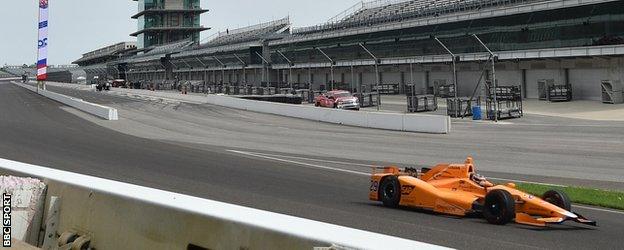
Alonso can expect to be on the edge during the race and qualifying
Former IndyCar driver Bryan Herta said at Alonso's rookie test: "He's going to be a pretty formidable competitor. He's got everyone's attention already."
De Ferran says: "I think most people are super-happy he has elected to come and do the Indy 500, primarily because Fernando commands a huge amount of respect.
"When I retired, someone asked what was one of your biggest frustrations, and I said I never really went head-to-head with Michael Schumacher and it was something I wanted to do.
"A lot of people see Fernando as I saw Michael and having the opportunity to race against a guy like that in similar equipment and so on is unique."
Can he win it?
Veteran Helio Castroneves said adapting to Indy racing would be "no problem" for Alonso. And four-time IndyCar champion and 2008 Indy 500 winner Scott Dixon said Alonso had a "great shot" at winning.
De Ferran says: "He has the skill, the experience, the knowledge, the emotional control to be a true contender in Indianapolis but there are so many things that have to come right on that one day for you to win.
"Let me put it this way, Mario Andretti tried God knows how long to win it for a second time and he only won it in '69. Scott Dixon, who frankly is supremely talented, won it only once.
"It's unbelievable. Yes, in the car you control a lot of levers but definitely not all of them. And there are some levers that not even the team controls.
"You have a bad pit stop and it happens to be the last one and you are in trouble. You may be dominating the whole race, but there's a strategy call, or a yellow that falls just at the wrong time, and you may be in trouble again. Or a mechanical failure.
"You make a bad decision in the car, once, and it happens to be at a crucial time, and you were in a position to win and now you're not."
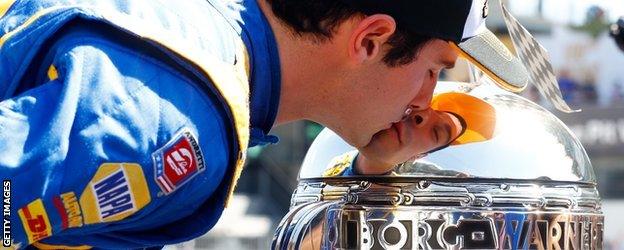
Can Alonso emulate Alex Rossi, who won the Indy 500 at his first attempt last year?
He uses as an example Alex Rossi, who drove five races for back-of-the-grid F1 team Manor in 2015, but won Indy at his first attempt last year, after gambling on not stopping for fuel after a late-race caution period.
De Ferran says: "If the yellow ended one lap sooner than it did, Rossi would not only not have won the race, he would not even have finished because he would have run out of fuel. That is one clear example between hero and zero that is completely beyond the control of the driver."
And what does Alonso himself think?
"First, I want to enjoy the experience," he says. "Everyone keeps telling me how big the event is. So my first target is to go there and live that moment. For any racing driver it must feel a privilege to race there.
"After that there is always a small percentage that you can win, because there are many factors there, it is not only about the pace.
"Probably my chance to win is a little lower than some of my competitors because I am lacking experience, but I have a lot of joy and commitment to learn as much as I can so it will be fun.
"But after that, when you close the visor you don't like it when you are are second. It's the same in any sport. We are all competitive and we want to do the best we can."
- Published3 May 2017
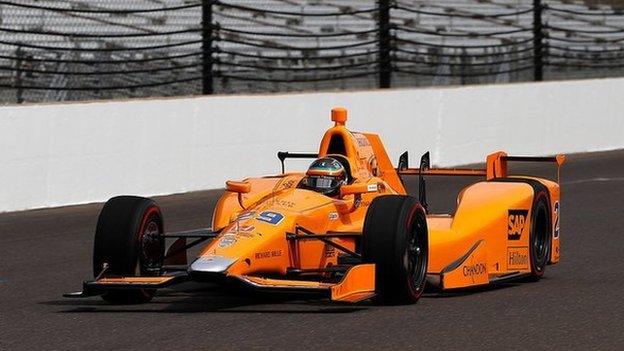
- Published12 May 2017
